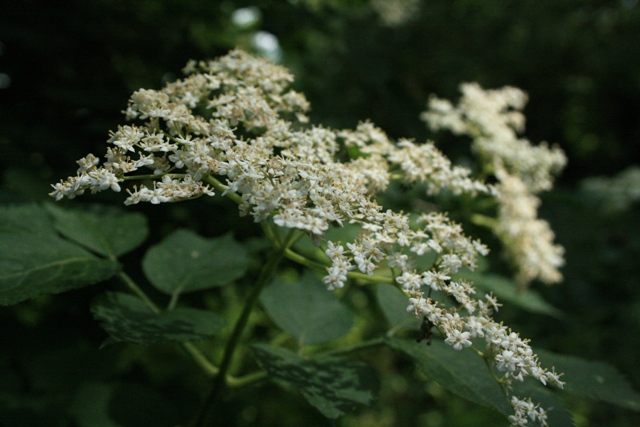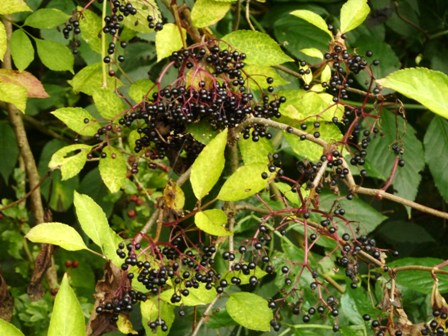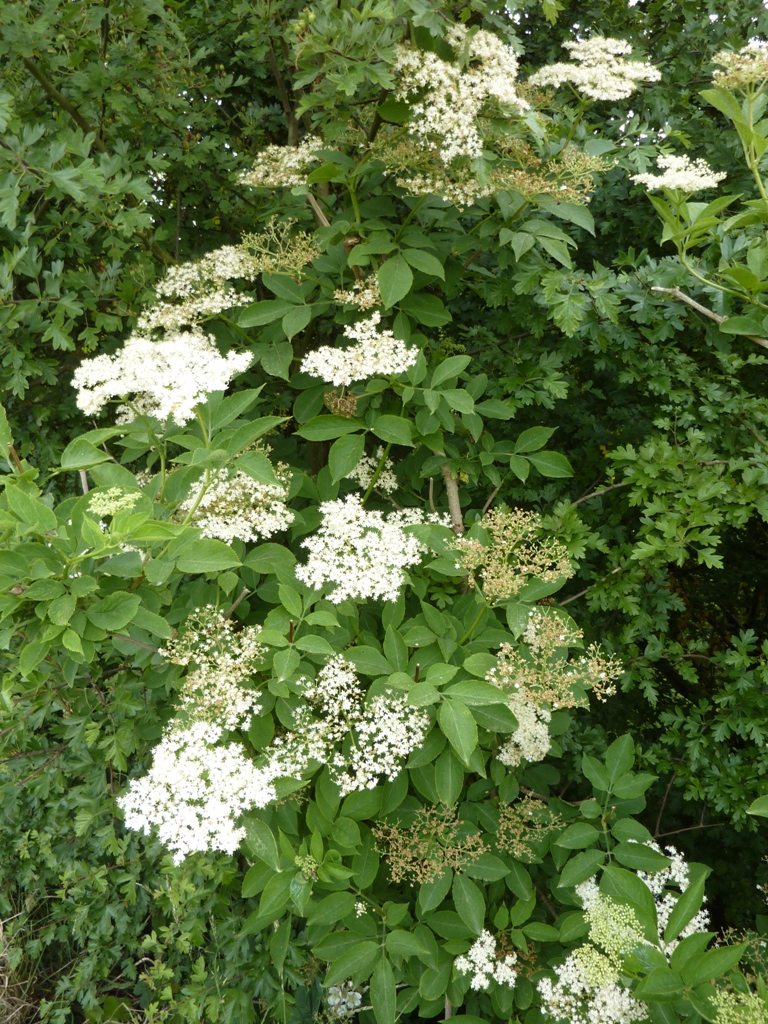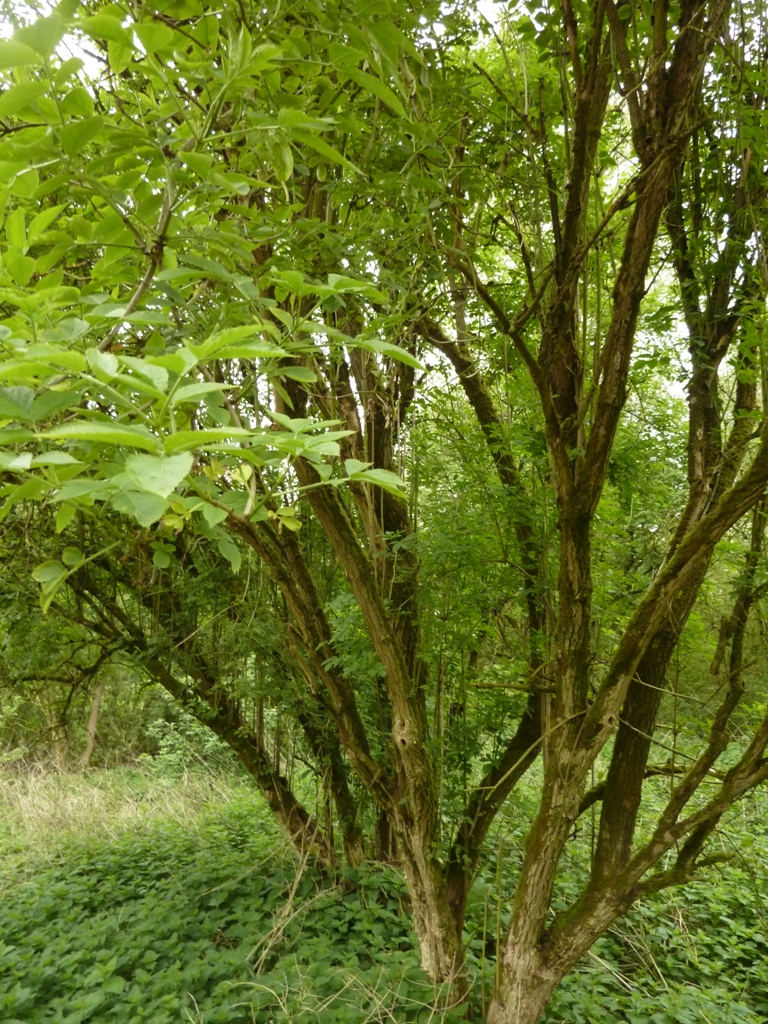
Sambucus nigra or Common Elder is a hugely useful plant and therefore cannot be called a weed at all!
It used to be a member of the Caprifoliaceae but now it belongs in the Adoxacea together with Viburnum and Adoxa with the most modern thinking in Plant Taxonomy.
I use colour coding for easy reading! Blue background is general interesting info (although I hope you find it all interesting!!). Green is about all the uses except for medicinal uses or if there is a warning in which case I use a pink background. Pictures and the poem on the end by Matt Summers.
Contents:
Sambucus nigra or Common Elder
Ornamental Uses
Edible Uses
Medicinal Uses:
Other Uses:
A Poem: ‘WITHIN THE GREEN’ (by Matt Summers)
Sambucus nigra or Common Elder
A deciduous shrub or small tree of fertile soils found in a wide range of habitats including woodland, hedgerows, grassland, scrub, waste ground, roadsides and railway banks. It is resistant to rabbit grazing and often occurs around warrens
Here first an extract from Natures Best Website about the elderberry:
For centuries, people have used the elderberry plant for its therapeutic properties. It was Hippocrates, the ‘father of medicine’, who first recognised the extraordinary health credentials of elderberries, using them to combat colds, flu, and allergies.
Elderberries are rich in tons of antioxidants, too (anthocyanidins, flavonols, and vitamin C, to be precise), meaning they also have the power to fight inflammation and free radical damage in the body. A report published in the Journal of International Medical Research revealed that when elderberries were consumed within the first 48 hours of catching flu, the symptoms dissipated approximately four days earlier than the average i. Plus, the use of pain relief was considerably less amongst those who received the elderberry compared to the placebo. When cold and flu season strikes, make sure your kitchen is well stocked with plenty of elderberry juice.
Ornamental Uses:
The common Elder is an attractive large shrub in all seasons for the garden and in farm hedges. The fragrant, creamy flower heads and dark burgundy bunches of berries are attractive for wildlife as well as for us.

Even in autumn the pungent leaves (when bruised) are attractive when they colour creamy yellow to peach and burgundy.
In winter when it’s leafless its silhouette is distinct with furrowed bark and sometimes with a common bright yellow lichen (Xanthoria parietina) decorating its branches!

It is also host of the Common Ear-fungus or Auricularia auricula-judae often seen on dying or dead branches in older specimens.
If the common Elder is not attractive enough for the ornamental garden there are many named cultivars with various coloured and shaped leaves. ‘Hilliers Manual of Trees and Shrubs (my 5th Edition)’ mentioned 11 cultivars, but there are many more in the latest 2019 edition and also to be seen on the RHS website!

Edible Uses:
There are many selected cultivars nowadays of the common elder with larger sized fruit, flowers and other qualities. See for many cultivars at the Agroforestry Research Trust shop.
Flowers:
- The flowers can be eaten raw and apparently a delicious crisp and somewhat juicy snack on a summer’s day.
- They can also be used in elderflower-fritters.
- The flowers are used to add a muscatel flavour to stewed fruits, jellies and jams (especially gooseberry jam).
- They are often used to make a sparkling wine.
- A sweet tea is made from the dried flowers.
Fruit:
- The flavour of the raw fruit is not acceptable to many tastes, though when cooked it makes delicious jams, preserves, pies and so forth.
- The fruit is used to add flavour and colour to preserves, jams, pies, sauces, chutneys etc.
- It is also often used to make wine.
Leaves:
- These are used to impart a green colouring to oils and fats.
Medicinal Uses:
Most of this information has been copied of the PFAF website-database ( Plants For A Future and I cannot take any responsibility for any adverse effects from the use of plants. Always seek advice from a professional before using a plant medicinally.
Elder has a very long history of household use as a medicinal herb and is also much used by herbalists. The plant has been called ‘the medicine chest of country people’.
The flowers are the main part used in modern herbalism, though all parts of the plant have been used at times.
Flowers:
- The fresh flowers are used in the distillation of ‘Elder Flower Water’. It is mainly used as a vehicle for eye and skin lotions.
- An infusion is very effective in the treatment of chest complaints and is also used to bathe inflamed eyes. It is a very good spring tonic and blood cleanser.
- Externally, the flowers are used in poultices to ease pain and abate inflammation. Used as an ointment, it treats chilblains, burns, wounds, scalds etc.
Fruit:
- The fruit is depurative, weakly diaphoretic and gently laxative.
- A tea made from the dried berries is said to be a good remedy for colic and diarrhoea.
- The fruit is widely used for making wines, preserves etc., and these are said to retain the medicinal properties of the fruit.
Leaves:
- The leaves can be used both fresh and dry. The leaves are purgative, but are more nauseous than the bark. They are also diaphoretic, diuretic,expectorant and haemostatic.
- The juice is said to be a good treatment for inflamed eyes. An ointment made from the leaves is emollient and is used in the treatment of bruises, sprains, chilblains, wounds etc.
Bark and Pith:
- The inner bark is diuretic, a strong purgative and in large doses emetic. It is used in the treatment of constipation and arthritic conditions. An emollient ointment is made from the green inner bark.
- The pith of young stems is used in treating burns and scalds.
- A homeopathic remedy is made from the fresh inner bark of young branches. It relieves asthmatic symptoms and spurious croup in children. The German Commission E Monographs, a therapeutic guide to herbal medicine, approve Sambucus nigra for cough and bronchitis, fevers and colds.
Other Uses:
Compost; Cosmetic; Dye; Fungicide; Hedge; Hedge; Insecticide; Litmus; Microscope; Musical; Pioneer; Pipes; Repellent; Wood.
- The plant is a valuable addition to the compost heap, its flowers are an alternative ingredient of ‘QR’ herbal compost activator and the roots of the plant improve fermentation of the compost heap when growing nearby.
- The leaves are used as an insect repellent; very effective when rubbed on the skin.
- The flowers are used in skin lotions, oils and ointments.
- Tolerant of salt-laden gales, this species can be grown as a shelter hedge in exposed maritime areas.
- This is an excellent pioneer species to use when re-establishing woodlands. It is very tough and wind-resistant, grows quickly and provides shelter for longer-lived and taller woodland species to establish.
As Dye:
- bark of older branches and the root have been used as an ingredient in dyeing black.
- A green dye is obtained from the leaves when alum is used as a mordant.
- The berries yield various shades of blue and purple dyes.
- They have also been used as a hair dye, turning the hair black.
- The blue colouring matter from the fruit can be used as a litmus to test if something is acid or alkaline. It turns green in an alkaline solution and red in an acid solution.
Pith and Wood Uses:
- The pith in the stems of young branches pushes out easily and the hollow stems thus made have been used as pipes for blowing air into a fire.
- They can also be made into musical instruments.
- The pith of the wood is used for making microscope slides and also for treating burns and scalds.
- The mature wood is white and fine-grained. It is easily cut and polishes well. Valued highly by carpenters, it has many used, for making skewers, mathematical instruments, toys etc.
Finally a poem by my partner Matt Summers about the virtue of the Elder:


WITHIN THE GREEN (by Matt Summers)
Flowers of purity
Berries of beauty
Elder statesman
Standing proud…
…Yet harmonious within the green
Lichen Winter branches
Are as bare bones clutching
The grey skies in waiting
For bud-break Spring…
…Sweet symmetry within the green
Blossom bleeds heavenwards
In a cream cascade
Showering clouds of Summer
Inviting insects inquisitive…
…A blazing torch within the green
As flowers fade
Late Summer transformation
Deep dark fruits
Blink as eyes opened in the depths…
…A harvest in waiting within the green
Fast falls the Autumn
Yellowed keepsakes float with the year
The final berry’s picked clean
This icon of the hedgerow…
…grows vigilant within the green
